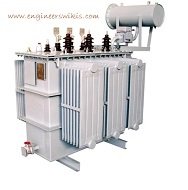
The working principle of a power transformer is based on the principles of electromagnetic induction. A power transformer is responsible for either stepping up or stepping down the voltage levels in electrical power transmission and distribution systems. Here is a simplified explanation of its working principle:
- Primary Coil (High Voltage Side): The primary coil, also known as the high voltage (HV) winding, is connected to the power source, such as a power generation plant or a high-voltage transmission line. It consists of a large number of turns of insulated copper or aluminum wire.
- Secondary Coil (Low Voltage Side): The secondary coil, also known as the low voltage (LV) winding, is connected to the load or the distribution network. It has a different number of turns compared to the primary coil, which allows for a different voltage output.
- Core: The primary and secondary coils are wound around a laminated iron core. The core provides a low reluctance path for the magnetic flux generated by the transformer.
- Magnetic Flux: When an alternating current (AC) flows through the primary coil, it creates a changing magnetic field around the coil. This changing magnetic field induces a magnetic flux in the iron core.
- Electromagnetic Induction: The changing magnetic flux in the core induces a voltage in the secondary coil according to Faraday’s law of electromagnetic induction. The induced voltage is proportional to the ratio of the number of turns in the secondary coil to the number of turns in the primary coil.
- Voltage Step-Up or Step-Down: The transformer can either step up or step down the voltage depending on the turns ratio between the primary and secondary coils. If the secondary coil has more turns than the primary coil, the transformer steps up the voltage. Conversely, if the secondary coil has fewer turns, the transformer steps down the voltage.
- Efficiency and Losses: Power transformers are designed to be highly efficient to minimize power losses during the transformation process. However, some losses, such as core losses (hysteresis and eddy current losses) and copper losses (I²R losses), occur in the transformer. These losses contribute to the transformer’s overall efficiency and can vary depending on factors such as load conditions and transformer design.
By regulating the turns ratio between the primary and secondary coils, power transformers facilitate the efficient transmission and distribution of electrical power at different voltage levels. They play a crucial role in delivering electricity from power generation sources to consumers while ensuring voltage regulation, power quality, and system stability.
